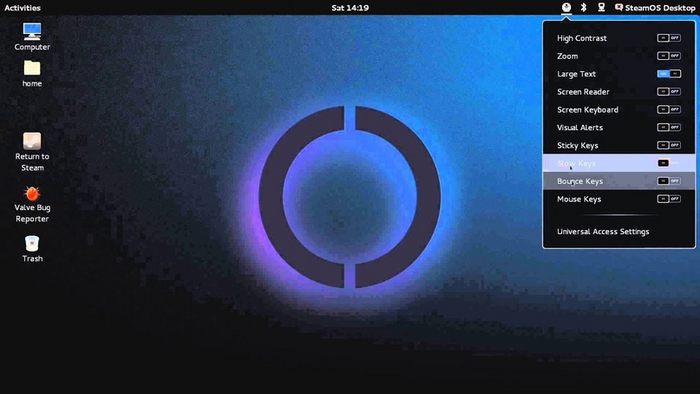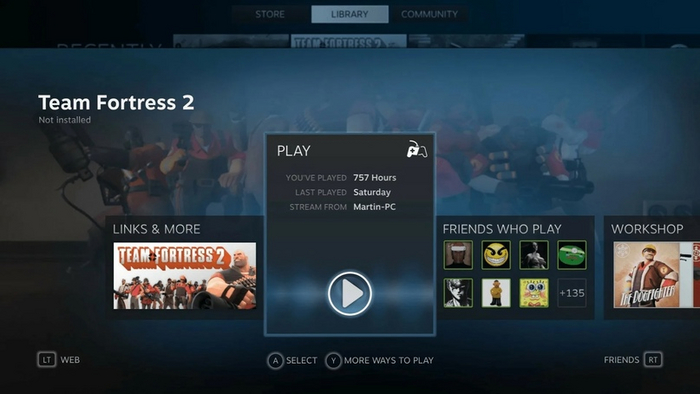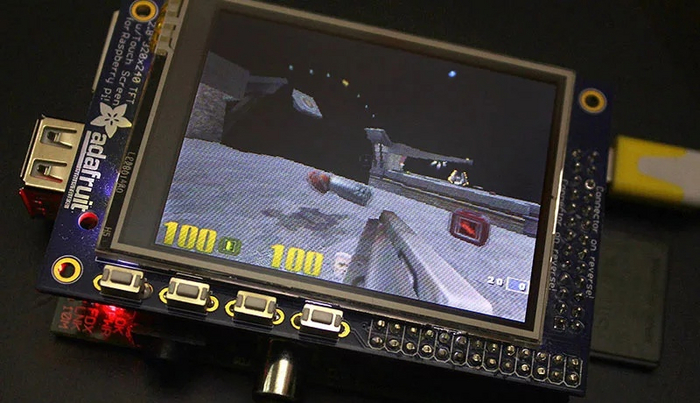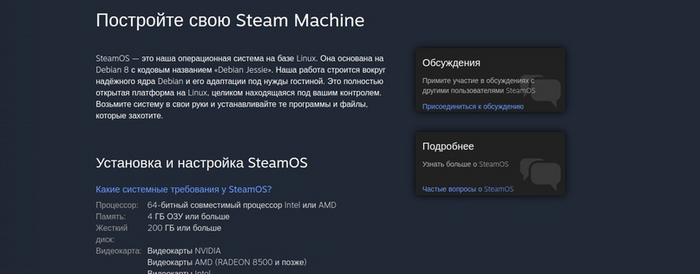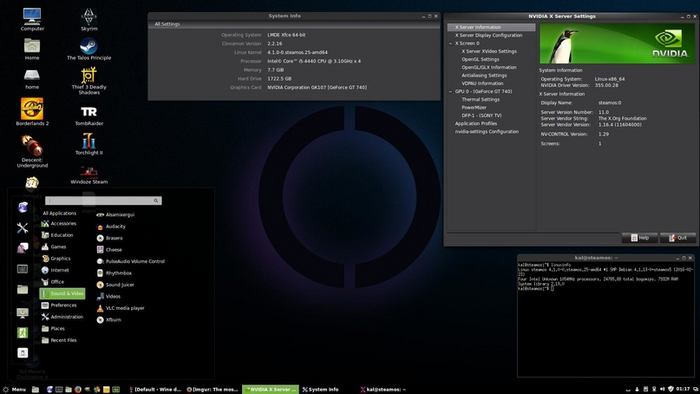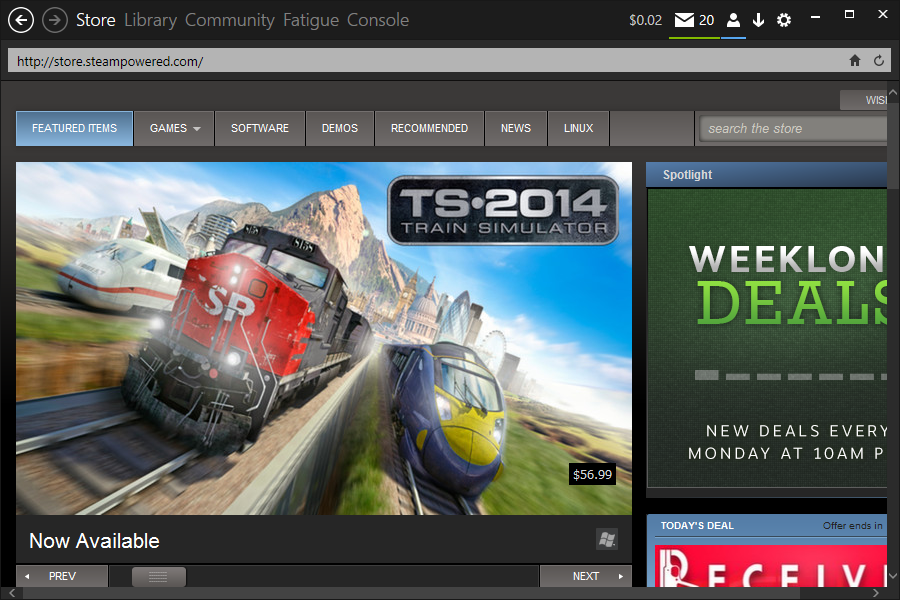Metro for steam как установить
Metro for steam как установить
Как установить тему оформления в Steam
Клиент Steam — не самое эстетически приятное приложение в любом смысле этого слова. Он медленно запускается, и навигация не самая удобная. Ускорить запуск Steam невозможно, возможно только ускорить загрузку игр в Steam. С удобством использования нечего не поделать, но с помощью тем оформления (скин) можно изменить внешний вид.
В этой статье я покажу, как установить самую популярную тему для Steam Metro.
Как найти темы для Steam
Темы для Steam похожи на темы для Windows 10 или скины для Minecraft. К сожалению нет одно определенного места где было вы возможно их всех просмотреть и скачать. Есть много различных мест, откуда можно скачать темы для Steam. Хороший тема Steam содержит много файлов и папок, поэтому она будет распространятся в виде zip-файла. В данной статье мы рассмотрим популярную тему Metro для Steam.
Как установить тему в Steam
Шаг 1: Скачайте лубую тему, и распакуйте ее. В этом примере я буду устанавливать тему Metro. После извлечения папки вы можете переименовать папку как хотите. Это имя будет отображаться в настройках выбора скина для Steam.
Шаг 2: После распаковки скопируйте папку и вставьте в папку скинов в Steam. Многие устанавливают Steam на системный диск Windows, который как правило является диском C, в то время как другие предпочитают устанавливать его на другие диски жесткого диска. Перейдите в папку «Steam» —> «Скины».
Шаг 3: Если вы никогда не устанавливали тему Steam, эта папка будет пустой, за исключением одного текстового файла. Вставьте извлеченную папку скина сюда. Вставьте всю папку в папку «Скины» вместо копирования файлов из нее.
Шаг 4: Откройте Steam и перейдите в меню Steam. Выберите Настройки. В окне настроек выберите вкладку «Интерфейс» и откройте раскрывающийся список под заголовком «Выберите скин, который вы хотите использовать в Steam». Выберите скин, который вы только что добавили в папку «Скины», и перезапустите Steam, когда вам предложат.
Шаг 5: Перезапустите Стим.
Когда Steam перезапустится, он будет иметь новый вид.
После установки тема не правильно отображается
Ранее я упоминал, что в хорошем теме Steam будет много файлов и папок. Если вы устанавливаете скин, а некоторые части клиента Steam все еще используют старый пользовательский интерфейс или что-то выглядит не так, возможно. Это происходит по причине того, что разработчик темы не изменил эту конкретную часть пользовательского интерфейса Steam.
К сожалению это невозможно исправить. Вы можете попробовать скачать и использовать другую тему или если это незначительная деталь попробовать обойтись без недостающего элемента оформления.
На этом все. Надеюсь данная статья была полезна, и вы смогли установить тему в Steam.
Metro for steam как установить
This skin enhances the default skin by giving the interface a clean yet modern look and feel based on Microsoft’s ‘Metro’ Design Language (now superseded by Fluent). To be honest, Steam’s default skin is quite ugly and out-of-date.
This complete guide works for all Steam platforms and operating systems (Windows, macOS and Linux). Some applications may require additional dependencies or only works on some operating systems. Check the repos linked for additional instructions or resources.
** New Name: SFP. Please use the new patcher, see the relevant section for more info.
There are a bunch of different styles and looks to choose from. Click the example screenshot link to see a preview of the skin.
Alternatively, you can use the Automatic Installer for Metro for Steam [github.com] to install the base skin and the unofficial patch at the same time. For instructions see the ‘Automatic Installer’ section. Make sure that you download the most recent version of the installer.
If manually installing, check the ‘Manual Installation’ section and this forum post on the Steam Group.
For the lazy, there’s an all-in-one package that contains a mix of everything here [github.com] by Hyoretsu/Bucetossauro.
Linux and macOS:
For Linux and macOS users, installing the mod is much easier, especially the Library and Friends/Chat skins. See their relevant sections for details.
For those that do not know any website creation whatsoever here is a short explanation of what certain abbreviation means.
CSS (Cascading Style Sheets) [www.w3schools.com] : Cascading Style Sheets as the name implies describes the style and look of a web page in HTML.
HTML (HyperText Markup Language) [www.w3schools.com] : Hypertext Markup Language creates the layout and the skeleton of a webpage. It is not a programming language but rather a markup language.
Javascript (often shortened to JS): [www.w3schools.com] Not to be confused with Java, a completely different programming language is a popular programming language for the web.
To enter into this mode, create a Steam shortcut and add ‘-dev’ (without quotes) to the ‘target’ field next to the location target address. Kill the current Steam process by either right-clicking the icon in the System Tray and selecting ‘Exit’, or going into the Hamburger Menu and selecting ‘Exit’. Click on the newly-created shortcut. Steam should launch and you should see ‘Console’ in the top row and when you press F6, the VGUI editor would popup. This is used to edit the base skin and view its properties.
When you enter the Store, Library, Chat or Friends List, press F12 to view the ‘DevTools’. This allows you to edit and view the code for the Store, Library, Friends List and Chat. In Library or Friends List press F5 to refresh the ‘page’ after an edit.
To exit out of ‘Dev Mode’ kill the current Steam process and launch a new instance of Steam from another shortcut.
See the relevant section.
The unofficial patch also has some extras to install, check the ‘Manual Installation’ section and this forum post on the Steam Group for a list of extras.
You would need the base skin and the unofficial patch. There are some extras that are only available using the manual installation method. This is a recommended method on macOS and Linux.
On Windows:
Extract the base skin file. Move the base Metro skin folder to the skin folder where Steam is installed on your computer. The default installation on Windows is C:\Program Files (x86)\Steam\skins. If the folder does not exist, just create one with the name ‘skins’ and place the skin there.
On macOS:
Place the skin folder in
/Library/ApplicationSupport/Steam/Steam.AppBundle/Steam/Contents/MacOS/skins or by right-clicking the app bundle ‘Steam.app’ located in Applications folder, then click ‘Show Package Contents’ where Steam is installed (usually in the Applications folder) and browse to /Contents/MacOS/skins.
On Linux:
Place the skin folder in
Optional: Then, choose and select any extras. (To see a preview of the extra, enter into the folder of an extra of your choice and find an image file.) Drag the files contained in the extra to the root directory of the Metro skin folder. Accept the overwrite of files. To remove/uninstall the extra, replace the files from the Main Files folder in the patch that you had replaced or reinstall the skin.
To update the entire skin, repeat the instructions.
If the update is small like a minor bug patch or a minor feature upgrade, download and replace the required file(s) stated on the ‘Announcements’ channel on the Unofficial Metro for Steam Discord. Head to the master folder on GitHub and find the stated file. Click on the file. Click on ‘Raw’ on the right-hand side of the page next to ‘Blame’ and ‘History’. Then right-click to save the file to the location where the skin is installed in the same location as where you had downloaded the file on the master folder (ie: \MetroSkin\resource\filename.res). Make sure to overwrite that file. Repeat if there is more than one file that needs updating.
This would reduce the need to replace or reinstall the entire skin. Not only this decreases file duplicates but also declutter your Downloads folder by only requiring you to replace the required file(s) needed for the update.
Run the application.
Click on the ‘Next’ under the Patched version.
Wait until the extras are loaded and select your extras to install. Make sure to check the checkbox to save the selected extras. Click ‘Install Now’.
Wait for the installation to complete.
Now it’s finished. Exit the application.
In the default Steam skin, go to the hamburger menu and click on settings, then Interface and in the dropdown box change from ‘default skin’ to ‘MetroSkin’. Steam will require you to restart.
The Automatic Installer would have a popup box indicating to you that there is an update to download. I recommend that you update the installer.
To update the skin, wait for an update to the installer and run the installer as normal. Check the patch notes on the releases page of the repo for details. Alternately, follow the instructions in the ‘Updating the Skin’ part of the ‘Manual Installation’ section of the guide if you want to quickly update the skin.
It looks like this!
Beware that the styles/decals for the library do not work anymore. Decals break the generated file, so it’s best not to select any decals. If you are going to use a custom font, make sure that the custom font is installed on your computer first, or it would default to the base font for Metro for Steam (a sans-serif font likely Segoe UI in Windows, Helvetica or Arial in macOS and Linux).
Click on ‘Save’ to download the file. Head to the location where your skin is installed (usually C:/Programs Files (x86)/Steam/Skins/MetroSkin for example). Override the file named ‘custom.syles’ and restart Steam.
Copy the hex code (e.g. for teal it’s 00aba9) or the RGB (Red Green Blue) code (e.g. for teal it’s 0,171,169) on the colour picker and paste them in their respective location(s) in the CSS file either next to
for teal and the hash (#) before the hex code.
Click the download link. It should be a CSS file names ‘webkit.css’. Right-click the lines of text/code and select ‘Save As’. Find a suitable location to save the file (e.g. Downloads).
If following from the repo, look for a file names ‘webkit.css’. Click on ‘Raw’ on the top right then right-click and choose ‘Save As’. Find a suitable location to save the file (e.g. Downloads).
Just move the file called ‘webkit.css’ in the folder to C:/Programs Files (x86)/Steam/Skins/MetroSkin/resource (or wherever Steam is installed) and overwrite the file. Restart Steam to see the changes.
If there is an update to the mod, replace the file ‘webkit.css’.
Replace or copy ‘webkit.css’ to:
Remember to add back the Library and Friends List/Chat modifications back to the ‘webkit.css’ when you update the Dark Mode mod.
NOTE: This section has been rewritten based on the new patcher, please uninstall the old one!
You will need the SFP formerly Steam Friend Patcher and the Metro for Steam modifications (‘libraryroot.custom.css’, ‘config.css’ [basically the Library modifications] and ‘friends.custom.css’ [the Friend’s List/Chat modifications]). Extract the files if needed to a safe place for easy access.
Click on ‘Windows’ if you’re using a Windows computer, ‘Linux’ if you’re using a Linux PC or ‘macOS X’ if you’re using a Mac. Ignore the last two files, you do not need them.
Open the application, you’ll be greeted by a screen with a log and three buttons ‘Patch’, ‘Start Scanner’ and ‘Reset Steam’. ‘Patch’ applies the modifications and resets Steam. ‘Start Scanner’ starts the scanning process manually in case there are any changes in the background or detect any issues with the process. ‘Stop Scanner’ stops it from scanning in the background. ‘Reset Steam’ just restarts Steam and empties the cache of the files to default (unmodded) in case something goes wrong.
Firstly, go into the ‘Settings’ tab and you’ll see some buttons and some commands. Fill in the line next to ‘Steam Directory’ by clicking on ‘Browse’ to change the location where Steam is installed. Find the location where Steam is installed (usually C:\Program Files (x86)\Steam\) and Click ‘Select Folder’. Make sure that ‘Patch Friends’, ‘Patch Library’ and ‘Patch on App Startup’ are checked. Click ‘Save’ at the bottom to save changes. These are critical to ensure that the modifications are patched every time you start your PC up. ‘Start minimised’ although optional should be checked as it allows the patcher to run in the background without annoying you. ‘Reload’ just resets the settings to default changes.
Extract and drag the CSS files named ‘libraryroot.custom.css’ and ‘config.css’ in the downloaded zip ‘steam-library-master’ to C:\Program Files (x86)\Steam\steamui (or wherever Steam is installed). Accept the override of the files.
Move the CSS file named ‘friends.custom.css’ to C:\Program Files (x86)\Steam\clientui (or wherever Steam is installed). Accept the override of the files.
After finishing, click on ‘Force Check’ option in the patcher and reload the Library and Friend’s List/Chat menus. You’re done!
Patcher is only required for the Library. You’ll need to follow below to modify the Friends List/Chat.
First, create a backup of the original ‘webkit.css’ or the ‘webkit.css’ with the Dark Mode mod installed in case something goes wrong by renaming the file from ‘webkit.css’ to ‘webkit.css.bak’ or creating a copy elsewhere. You can rename it back to ‘webkit.css’ to revert any changes.
To install the friends’ skin of your choice, copy or replace the contents named ‘friends.custom.css’ in the same location as above. Make sure to leave a gap under the main ‘webkit.css’ code. ‘YourSkinName’ would be the Metro Skin.
For the Library follow the earlier set of instructions.
Optional:
Leave some gaps in the CSS file. Add some comments like
for example, underneath or above the code to easily distinguish and identify between the mods for updating or editing.
You may need to add additional CSS code or files to override or replace the original code if you intend to customise or personalise the skin, which may require CSS knowledge. Not a recommended method to install the mods due to the lack of customisation. Only recommended for people that want an easy way to update the mods.
Repeat these instructions in the relevant sections above if you are updating the mod(s). Check the Discord for regular updates and patch notes or in the repo of the mod.
You can edit the CSS file(s) to your preferences at your own risk. Knowledge of CSS may be required. ‘Config.css’ is the CSS file to edit for the Steam Library. Make sure you know what you’re doing and read the headings or comments in green. Keep backups just in case.
When choosing colours, I recommend that you use the accent colour that you chose in the ‘Personalisation’ section of the guide. To modify the Steam Library, insert the code in ‘Libraryroot.custom.css’ make sure to add
(this line modifies the top header of the navigation bar in the Steam Library).
You can enable ‘Small Mode’ of the Library by clicking the Steam logo and selecting it in the dropdown menu (if you are using the latest version of the unofficial patch) and you can go back to the large mode by selecting ‘Large Mode’.
Oh, Jonius7 created an application [github.com] that changes the layout of the library via CSS and JS. Here’s a video tutorial on it and make sure to read the description of the video and the repo.
After making the changes, make sure to save and reload the Library by leaving the library to the Store or Community Hub and then re-entering back into the library.
I recommend deleting all unused downloaded files from this guide and cleaning up your Downloads folder after the installation has completed.
These are optional extras for your Steam Library!
These white logo covers and artwork look like this!
Check out https://www.steamgriddb.com/ to download more covers and share them with others. Download the manager [www.steamgriddb.com] to change the covers of your installed games.
Here is an application that finds game covers: Steam Grid Cover Finder [github.com] created by AriJKh. Make sure to install GraphicsMagicK [www.graphicsmagick.org] if you want the app to automatically create a game cover when the app can’t find one.
Here’s another cover ‘grabber’: Steam Grid [github.com]
Also, check out r/steamgrid as well for extra resources, links or just to share!
To change the covers: right-click the game cover and select ‘Manage’ then ‘Set custom artwork’. Choose the artwork.
Metro for Steam. Изменяем внешний вид Steam.
SteamOS — Консоль из любого устройства
SteamOS — это, операционная система, основанная на Arch Linux, разрабатываемая корпорацией Valve специально для сервиса Steam. SteamOS была ориентирована для запуска игр на экране телевизора. Она стала доступна в качестве бесплатной операционной системы для пользователей и свободно лицензируемой для разработчиков.
Steam в режиме BIGPICTURE:
Консоль из любого устройства
Если вы посмотрите в интернет, то многие устанавливают Linux через особую прошивку на мобильные телефоны, так-как SteamOS тоже считается unix системой, то установка его на мобильные устройства не будет проблемой. Правда проблемой окажется недостаток, а если быть точнее — то полное отсутствия USB-портов. Так-же не все будет работать идеально на мобильном устройстве.
Многие умельцы устанавливали SteamOS на платы Rasbery pi, медиацентры, телевизоры и компьютеры. Linux в таком случае запускается заранее с включенным клиентом Steam и для взаимодействия системой, можно использовать геймпад, мышь или клавиатуру.
Зайдя на официальный сайт, мы увидим следующие системные требования:
Процессор: 64-битный совместимый процессор Intel или AMD
Память: 4 ГБ ОЗУ или больше
Жесткий диск: 3,7 ГБ для установки
Видеокарта: NVIDIA, AMD (RADEON 8500 и позже), Intel
А также: USB-порт для установки, поддержка UEFI (рекомендуется)
Как установить SteamOS?
Существует несколько способов установки SteamOS. Рекомендуется использовать автоматическую установку, при которой диски настраиваются по заранее заданной схеме. Другой способ использует установщик Debian, который позволяет провести настройку после автоматической начальной установки.
Переходим на официальный сайт из заходим в раздел «Steam OS», этапы установки выборочной и автоматической установки были взяты с официального сайта Steam, поэтому можете даже не переходить по ссылке.
2. Распакуйте файл SteamOS.zip на отформатированный USB-накопитель с файловой системой FAT32. Убедитесь, что используется формат раздела MBR.
3. Подключите USB-накопитель к нужному компьютеру. Запустите компьютер и выберите в BIOS загрузку с USB-накопителя (обычно клавиша F8, F11 или F12 открывает меню загрузки BIOS).
4. Убедитесь, что выбран интерфейс UEFI. Он выглядит примерно так: «UEFI: Patriot Memory PMAP». Если отсутствует UEFI, вам нужно включить поддержку UEFI в настройках BIOS.
5. В меню выберите автоматическую установку (СОТРЕТ ВСЕ ДАННЫЕ С ДИСКА!).
6. Оставшаяся часть установки не потребует вмешательства. В этот момент будет происходить разбивка вашего жесткого диска на разделы и установка SteamOS.
7. После завершения установки система перезагрузится и начнет устанавливать Steam. На этом этапе потребуется соединение с интернетом — если оно присутствует, Steam установится автоматически. Если соединения с сетью нет (например, нужно сначала подключиться к точке доступа Wi-Fi), система сообщит вам об этом, и перед вами появится окно настройки сети, в котором вы сможете осуществить подключение. Когда произойдет соединение с интернетом, закройте окно настройки, и Steam начнет устанавливаться.
8. После установки Steam компьютер перезагрузится и создаст резервную копию системного раздела на жестком диске.
9. Когда резервное копирование закончится, выберите «Перезагрузка» и запустите вашу новенькую SteamOS.
2. Распакуйте файл SteamOS.zip на отформатированный USB-накопитель с файловой системой FAT32. Убедитесь, что используется формат раздела MBR.
3. Подключите USB-накопитель к нужному компьютеру. Запустите компьютер и выберите в BIOS загрузку с USB-накопителя (обычно клавиша F8, F11 или F12 открывает меню загрузки BIOS).
Убедитесь, что выбран интерфейс UEFI. Он выглядит примерно так: «UEFI: Patriot Memory PMAP».
4. Если отсутствует UEFI, вам нужно включить поддержку UEFI в настройках BIOS.
5. В меню выберите выборочную установку.
6. Укажите предпочитаемый язык, местоположение и раскладку клавиатуры.
7. Вы сможете по-своему разметить диск для выделения места под систему.
8. Оставшаяся часть установки не потребует вмешательства. В этот момент будет происходить разбивка вашего жесткого диска на разделы и установка SteamOS.
9. После завершения установки система перезагрузится и начнет устанавливать Steam. На этом этапе потребуется соединение с интернетом — если оно присутствует, Steam установится автоматически. Если соединения с сетью нет (например, нужно сначала подключиться к точке доступа Wi-Fi), система сообщит вам об этом, и перед вами появится окно настройки сети, в котором вы сможете осуществить подключение. Когда произойдет соединение с интернетом, закройте окно настройки, и Steam начнет устанавливаться.
10. После установки Steam компьютер перезагрузится и создаст резервную копию системного раздела на жестком диске.
11. Когда резервное копирование закончится, выберите «Перезагрузка» и запустите вашу новенькую SteamOS.
SteamOS имеет готовые и установленные драйвера для геймпадов и других устройств, имеет заранее и автоматически запускаемый клиент Steam, который запускается в режиме Bigpicture и тем самым делает его консольным и удобным для использования на телевизорах, или через геймпад. SteamOS используется в их портативных консолях Steam Deck, SteamMashine что обеспечивает его стабильность в работ. Среди пользователей, ужасной работы не наблюдалось!
Мы можем купить любую плату которая поддерживает работу как компьютера, установить на неё SteamOS, подключить 1-2 геймпада и играть в любимые с друзьями, нося эту консольку с собой прямо в кармашке, как это сделали с платами Rasbery pi. Сам SteamOS настроенный, стабильный и имеет на борту Proton для запуска большинства игр которые были написаны исключительно на Windows.
Metro for steam как установить
Платформа: Windows
Версия: AIMP v4.10 или более новая
Форма: Горизонтальная
Тон: Темный
Поверхность: Матовая
Версия: AIMP v3.55 или более новая
Форма: Вертикальная
Тон: Средний, Темный
Поверхность: Матовая
Версия: AIMP v3.55 или более новая
Форма: Горизонтальная
Тон: Средний
Поверхность: Матовая
Подробнее..
Версия: AIMP v4.10 или более новая
Форма: Горизонтальная
Тон: Темный
Поверхность: Матовая
Интерфейс: Hi-Fi
Подробнее..
Версия: AIMP v2.60 или более новая
Форма: Горизонтальная
Тон: Темный
Поверхность: Стеклянная
Подробнее..
Версия: AIMP v4.00 или более новая
Форма: Горизонтальная, Все-в-одном (All-in-One)
Тон: Светлый
Поверхность: Матовая
Интерфейс: Тематический
Подробнее..
Версия: AIMP v4.00 или более новая
Форма: Вертикальная
Тон: Темный
Поверхность: Aero, Матовая
Адаптированная версия скина по умолчанию от AIMP3 для AIMP4
Подробнее..
Версия: AIMP v4.00 или более новая
Форма: Горизонтальная
Тон: Темный
Поверхность: Матовая, Стеклянная
Интерфейс: Hi-Fi
2-head single compact cassette deck
Stereo Integrated Amplifier A Class
Подробнее..
Версия: AIMP v4.00 или более новая
Форма: Горизонтальная
Тон: Темный
Поверхность: Матовая, Стеклянная
Интерфейс: Hi-Fi
The Sony TC-RX80 (1988) is auto reverse, 2-head, single compact cassette deck.
The Sony TA-N77ES (1988) is stereo power amplifier, 200 watts per channel into 8Ω.
Подробнее..
Стандартный GameMenu.res
GameMenu.res отвечает за кнопки в меню с левой стороны.
Это стандартный файл GameMenu.res, без каких либо изменений, используемый в Counter-Strike 1.6.
Нужен, если Вам испортили меню «Рекламой», ссылками на сервера, web ресурсы.
В общем, изменили меню, добавив непонятные кнопки, ведущие на ненужные Вам сервера или сайты.
Или например, не открывается меню options, new game. Не срабатывают кнопки в меню.
Или же, в случае перенаправления, жмете options, new game, find server, а вас закидывает на не понятный сервер.
Подробнее..
Суть данной утилиты проста до не могу – настроить громкость микрофона.
Подробнее..
Устранение неисправностей на «корявых» патчах.
Default menu background (Стандартный фон меню.
Стандартный фон меню Counter-Strike 1.6
Используется для восстановления исходной картинки, в меню Counter-Strike 1.6
Установка:
Просто извлечь содержимое архива, в корневую директорию игры.
Если еще проще, извлечь папку cstrike из архива, в папку с hl.exe.
Watermark присутствует только на скриншоте 🙂
Подробнее..
Набор из 247-ми монохромных логотипов (logos).
13 стандартных картинок:
Ето лого которые доступны изначально.
234 новые картинки:
Гербы
Дорожные знаки
Логотипы: авто концернов, телеканалов, торговых марок,…
Надписи
Предупреждающие знаки
Символика
И многое другое
ESWC models
RockTheVote Custom V1.8 (rtv)
Описание:
Плагин позволяет игрокам на сервере организовывать голосования за смену карты.
Чтобы голосование состоялось, определённое количество игроков должно написать в чате «/rockthevote», «rockthevote» или «rtv».
Карты будут автоматически загружены из файла maps.ini (если таковой существует) или из файла mapcycle.
Установка:
1. Поместить rockthevote_custom.amxx в папку plugins
2. Прописать rockthevote_custom.amxx плагин в файле plugins.ini
3. Открыть файл конфигурации amxx.cfg и прописать там необходимые переменные
4. Рестартануть или сменить карту
Reklamko
Metro for Steam (Windows 8)
Описание:
Скин игрового клиента Steam, выполненный в стиле Metro (Windows 8 / Microsoft, Metro UI).
Подробнее..
High Ping Reducer
Описание:
Плагин вместо того чтобы кикает пингеров уменьшает число посылаемых им пакетов. Что делает для пингера игру хуже( менее плавные анимации\ не всегда правильное отображение игроков) Но у пингера значительно понижается пинг ( и он уже не тормозит сервер) вы спросить на сколько? это зависит от самого игрока = ) Было что у чела понизило пинг с 180-200 к 70. Бывает что с 80 до 50. С 50 до 30. У меня был стабильно был 5(LAN) а плагин понизил что стало колебаться 0-5.










